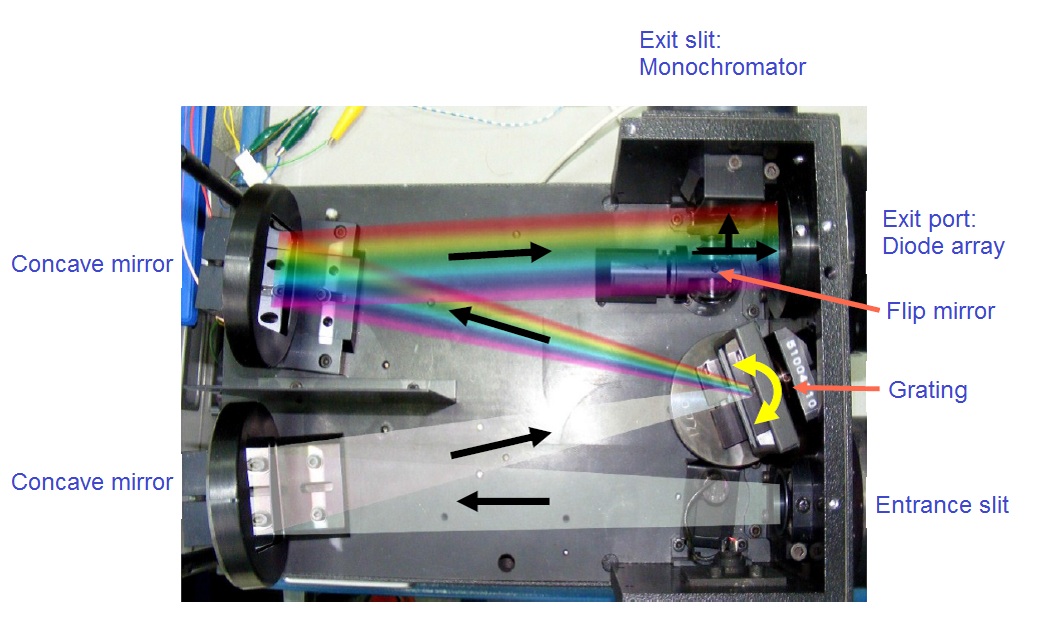Gauges and measuring systems for evaluating quantities of optical radiation
The laboratory for optical radiation has the necessary measuring systems to measure quantities of optical radiation pursuant to the OStrV (Occupational Safety and Health Ordinanace on Artificial Optical Radiation). Due to its own calibration standards, all measurements can be traced back to the reference standards of the PTB.
Spectroradiometer
The spectral method is a basic method where a spectroradiometer is used to measure the spectral radiation intensity and the spectral radiance in dependence on the wavelength, respectively. In order to compare with thresholds, the raw data must be evaluated with the action spectra.

Regarding the spectroradiometers, one distinguishes between two designs. If there is a detector at the outlet, e.g. a diode or a highly sensitive photomultiplier tube, the wavelength is scanned step-by-step. If a defined spectral range is to be captured in a short period of time, a spectrometer with a photodiode array or CCD array is necessary.
Double monochromator
With this type of device, a defined spectral range is scanned in discrete steps. A spectroradiometer may be designed as a single or a double monochromator. Regarding the double monochromator, a second monochromator is connected in series to the first one.
An essential difference between these two designs is the stray light rejection. Stray light is the part of the radiation coming from wavelength ranges not covered by the measurement. While a single monochromator is characterised by a stray light rejection of 10-4 (corresponds to a signal-to-noise ratio of 104), it is significantly better for the double monochromator with 10-8. Particularly for measurements in the UV range with a low share of radiation in the UV range and a high share of radiation in the visible and IR range, it is recommended to use a double monochromator in order to reject the stray light. When using a single monochromator, the stray light may result in an over-assessment of the exposure.
Advantages:
- measurements at high accuracy for temporally constant radiation intensities
- exact weighting when evaluating with action spectra
Disadvantages:
- long measurement time
- not suitable for measuring sources with temporally variable radiation intensities
Spectroradiometer with array detector
Regarding this type of device, normally a grid is mounted in a fixed position and orientation in the spectrometer. The broadband radiation is mapped on an array of detectors (e.g. on a photodiode or CCD array). Here, each detector is assigned to a certain wavelength.
Since no mechanical scanning motion is required for this type of spectroradiometer, it is possible for a complete spectrum to be scanned very rapidly (within milliseconds). This instrument is therefore suitable for measuring sources with temporally variable radiation intensities. Current array spectrometers with stray light suppression deliver good measurement results in the UV spectral range.
Advantages:
- quick procedure
- suitable for the evaluation of sources with temporally variable radiation intensities
- compact system
Disadvantages:
- limited measurement sensitivity
- higher levels of false light in the UV spectral range without stray light suppression
- small systems usuall characterised by greater measurement uncertainties
Integral radiometer
As opposed to the spectral method, the integral method determines and directly displays a measured result for one spectral range. Adaptation to a defined spectral range or to an evaluation function is achieved by selecting suitable filters and a detector with selective spectral sensitivity. This adaptation is particularly difficult when emulating steep action curves and may involve an increased measuring error.
The gauges may be of stationary design or may be worn on the body as personal dosimeter.
Advantages:
- direct display of the measurement result
- evaluation of sources with temporally varying radiation variables
- compact gauge with easy handling
- battery operation possible
- cheaper than spectrometers
Disadvantages:
- evaluation function may be emulated inaccurately
Calibration standards
During calibration, the gauge to be calibrated is used to measure a reference source (calibration standard). The measured data is compared to the target values of the reference source. This way, deviations can be determined and corrections can be performed, if required. A well calibrated gauge is a prerequisite for an exact measurement.
Calibration should be repeated at regular intervals in order to maintain the quality standard. The period of validity of the calibration must be documented in the calibration certificate.




